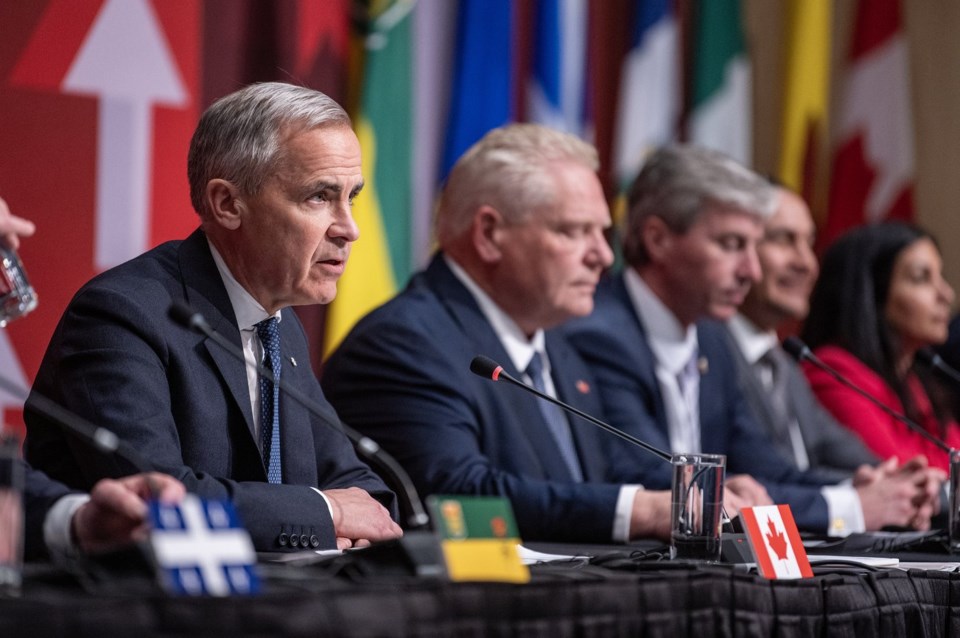OTTAWA — The federal government and Canada's premiers are greatly overselling the benefits of breaking down internal trade barriers, the Canadian Centre for Policy Alternatives argues in a new report.
The left-leaning think tank's report reviews the steps taken by Ottawa and the provinces to eliminate red tape, calling them "political theatre" that will do little to mitigate the damage from U.S. President Donald Trump’s trade war or bolster the economy.
Prime Minister Mark Carney vowed throughout the spring election to forge "one Canadian economy" with the premiers by eliminating internal barriers to trade and labour mobility in response to Trump’s tariffs.
The report, titled “The premiers’ new clothes,” reviews legislative and other changes put forward by the federal government and the provinces.
It concludes that elected officials have cited “very few practical examples of barriers” to support legislative moves that could eliminate regulatory tools for “supporting local economic development and ensuring high standards for goods, services and labour certification.”
Marc Lee, senior economist at the think tank and co-author of the paper, said Canadians need to "dramatically" lower their expectations of expanded internal trade and warned it's not worth the risks of quickly overturning scores of protective regulations.
"Even if there are some minor gains to be made, it's nowhere close to the losses that we're seeing currently on Canada-U.S. trade. It's not really a substitute for addressing the Trump tariffs," he said.
Internal Trade Minister Chrystia Freeland's office contends that trade within Canada is an "essential driver" of the economy and that it needs a boost, given the current trade friction with the U.S.
"Enhancing internal trade and removing barriers will be a key tool to counter the impact of U.S. tariffs," said Laura Scaffidi, Freeland's director of communications.
"We said to Canadians that we would be ready, and that we would fight for Canadian interests, and we are.”
The report lands after a flurry of trade activity in recent months, including new legislation, memorandums of understanding signed between provinces and the removal of rules from the Canadian Free Trade Agreement. It's all meant to grease the wheels for businesses moving goods and services between provinces.
Some of these changes include efforts to make it easier to sell beer, wine and spirits across provincial borders by, for example, enabling direct-to-consumer alcohol sales.
The country’s internal trade ministers are meeting in Quebec City on Tuesday to discuss next steps, which are expected to include a review of trucking industry regulations.
Freeland has pointed to studies that say internal trade barriers amount to a seven per cent tariff that Canada imposes on itself, and that removing them could boost the economy by up to $200 billion.
Lee said he thinks that's unlikely.
"To the extent that there's any low-hanging fruit from removing barriers, it's already been picked a long time ago," he said. "And this idea that we're going to get $200 billion, it's just fantasy."
One of the problems with analyzing the cost of provincial rules that might impede trade is a lack of data. There is no comprehensive list of existing internal trade barriers within Canada, or even agreement on what those barriers are.
Supply management, for instance, could count for some as an interprovincial barrier, since it relies on a quota system.
The federal government recently passed Bill C-5, which is designed in part to make it easier to sell goods or to work in other provinces.
It does this by eliminating federal requirements where there are already similar provincial ones in place — such as energy efficiency requirements for sales of consumer appliances.
Skilled trades, for example, face overlapping provincial regulations that can lead to workers having to undergo repeat technical training on the same subject.
But the CCPA report said that only about six per cent of Canadian workers are in professions that are federally regulated — meaning the new law will have little impact on most employees.
Many of the specifics of the new law will come out in regulations in the coming months.
This report by The Canadian Press was first published July 7, 2025.
Kyle Duggan, The Canadian Press



